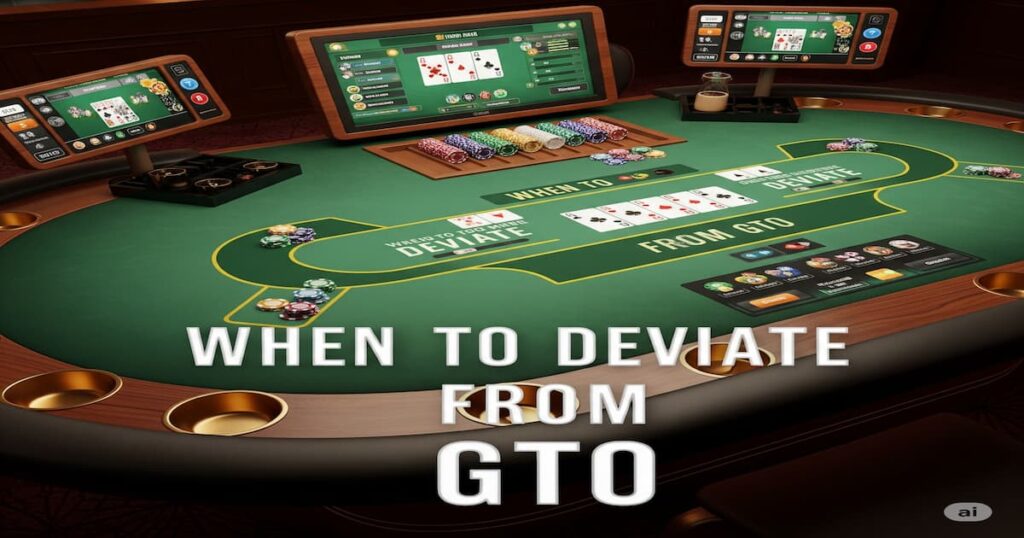While a solid foundation in Game Theory Optimal (GTO) poker is crucial, the real key to maximizing your success at the table lies in knowing when and how to deviate from it. Your human opponents are not GTO bots; they make mistakes and have predictable tendencies.
By learning to adapt your strategy to exploit these tendencies, you can significantly increase your win rate.

Why Deviate? The Art of Exploitation
The core reason to stray from a GTO strategy is to exploit the mistakes your opponents make. Human players frequently diverge from GTO, and by recognizing these common deviations, or “population’s mistakes,” you can make adjustments that capitalize on their errors. This adaptive approach is what can elevate your win rate, potentially reaching 7 to 8 big blinds even against skilled regulars.
Guiding Your Adaptation: Two Key Questions
When you find yourself in a tough spot, particularly when facing a potential bluff, asking yourself a couple of targeted questions can help you navigate the situation:
- How many hands that could be bluffs on the river are in your opponent’s pre-flop range?
- Of those hands, how many actually make it to the river?
For example, a player calling from the big blind pre-flop has a wide range that includes many potential bluffs like flush draws, straight draws, or overcards. However, many of those hands, such as overcards that don’t connect with the flop, might not continue to the river. Analyzing the situation this way helps you more accurately assess the likelihood that your opponent is bluffing.
Adapting to Different Player Types
How you deviate from GTO will depend heavily on the type of opponent you are facing.
Against Tough Regulars
Skilled regulars also deviate from pure GTO, and recognizing these subtle shifts is key.
- Adjust to Bluffing Frequencies: If you notice a regular check-raises the flop more often with hands that would typically become river bluffs, their range of bluffs on the river is consequently reduced. This adjustment can change a profitable GTO call into a marginal one, or even a fold. Similarly, if an opponent bluffs less frequently with certain hands, like busted flush draws, your calls become less profitable.
- Play “Looser” Than a Solver: Sometimes, you might need to make calls that a GTO solver wouldn’t approve of. This can be the right play if an opponent’s pre-flop range is wide and they are likely to arrive at the river with too many bluffs because they lack alternative lines.
- Consider Their Value Bets: You should also consider the possibility that your opponent might be over-betting for value with certain hands, which will also influence your decision-making.
Even minor adjustments in your opponent’s strategy can turn what seems like a clear GTO call into a losing play, underscoring the importance of careful observation.
Against Recreational Players
When playing against recreational opponents, you can often throw the idea of a balanced strategy out the window.
- Forget Balance, Maximize Profit: Recreational players are less likely to adjust to your strategy, so there’s no need to balance your play. Your primary objective should be to read their hand and choose the bet size that will make you the most money in that specific spot.
- Exploit Predictability: Recreational players often have predictable betting patterns. For instance, if a player’s actions suggest a very strong hand (like a Queen) but they then check the river, it’s a strong indicator they don’t have the hand they were representing.
- Use Unconventional Sizing: A powerful exploitative tool is unconventional bet sizing. In one example, a player named Davy Jones made a tiny 10k bet with trips on the river, even though GTO would suggest an all-in. This “genius” move was based on the read that a recreational player would only call the small bet with a wide range of weaker hands (like Ace-high or small pairs) or could even be induced to bluff-raise. An all-in bet, conversely, would have folded out all those weaker hands. This is a form of “real life GTO” tailored to the specific opponent.
Ultimately, deviating from GTO successfully is about moving beyond rigid mathematical perfection. It requires you to be a keen observer of your opponents’ actions and make calculated, exploitative adjustments based on their specific tendencies and likely hand ranges.
